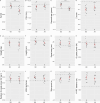A pilot study on bio-banding in male youth ice hockey: Players' perceptions and coaches' selection preferences
- PMID: 39133685
- PMCID: PMC11318913
- DOI: 10.1371/journal.pone.0308676
A pilot study on bio-banding in male youth ice hockey: Players' perceptions and coaches' selection preferences
Abstract
Classifying athletes based on estimates of biological maturation (i.e., bio-banding) as a supplement to traditional age grouping has been shown to be a potential tool for enriching player development in team sports; however, bio-banding has not yet been evaluated in ice hockey. The primary aim was to investigate player experiences and coaches' selection preferences in bio-banding versus age-banding in a group of 12-13-year-old (early growth spurt) male elite players (n = 69). We also examined the relationship between somatic maturity, expressed as a % predicted adult height (%PAH), and fitness performance. Bio-banding was assessed using a questionnaire and 29 coaches selected their top players in each game based on age or bio-bands. %PAH correlated with grip strength (r = .57, p>0.001) and jumping power (r = .63, p<0.001), but not with vertical jump height, sprint time or endurance. Players who played against more mature players in bio-bands than in age groups experienced higher demands, while players who played against less mature players were able to utilize their skills to a greater extent. Coaches generally favored later-than-average maturing players who performed better on performance tests and chronologically older players in bio-banding. We conclude that bio-banding in youth ice hockey has some promising effects and warrants further evaluation.
Copyright: © 2024 Lindholm et al. This is an open access article distributed under the terms of the Creative Commons Attribution License, which permits unrestricted use, distribution, and reproduction in any medium, provided the original author and source are credited.
Conflict of interest statement
TRL has received financial compensation from the Swedish Ice Hockey Association for consultancy work. JL is employed by the Swedish Ice Hockey Association. EN has received reimbursement of travel expenses from the Swedish Ice Hockey Association. The specific roles of these authors are articulated in the ‘author contributions’ section. The Swedish Ice Hockey Association did not have any additional role in the study design, data collection and analysis, decision to publish, or preparation of the manuscript. This does not alter our adherence to PLOS ONE policies on sharing data and materials (see data availability statement).
Figures






Similar articles
-
Off-ice fitness of elite female ice hockey players by team success, age, and player position.J Strength Cond Res. 2013 Apr;27(4):875-84. doi: 10.1519/JSC.0b013e3182651fd2. J Strength Cond Res. 2013. PMID: 22739329
-
Coach selections and the relative age effect in male youth ice hockey.Res Q Exerc Sport. 2013 Mar;84(1):126-30. doi: 10.1080/02701367.2013.762325. Res Q Exerc Sport. 2013. PMID: 23611016
-
Fitness Characteristics of Elite and Subelite Male Ice Hockey Players: A Cross-Sectional Study.J Strength Cond Res. 2019 Sep;33(9):2352-2360. doi: 10.1519/JSC.0000000000003285. J Strength Cond Res. 2019. PMID: 31343551
-
Bio-Banding in Youth Sports: Background, Concept, and Application.Sports Med. 2019 Nov;49(11):1671-1685. doi: 10.1007/s40279-019-01166-x. Sports Med. 2019. PMID: 31429034 Review.
-
The psychology of bio-banding: a Vygotskian perspective.Ann Hum Biol. 2020 Jun;47(4):328-335. doi: 10.1080/03014460.2020.1797163. Ann Hum Biol. 2020. PMID: 32674664 Review.
Cited by
-
Selection of the Extremes - Male Junior and Adult Ice Hockey Success in relation to Relative Age and its Interaction with Biological Maturation.Sports Med Open. 2025 Sep 8;11(1):102. doi: 10.1186/s40798-025-00902-0. Sports Med Open. 2025. PMID: 40921934 Free PMC article.
References
MeSH terms
LinkOut - more resources
Full Text Sources

